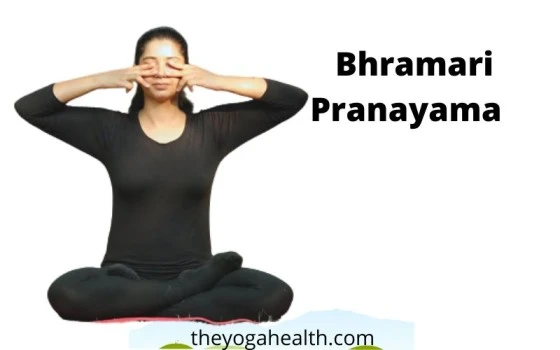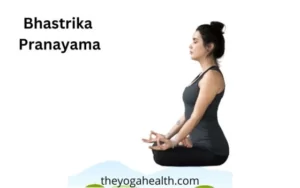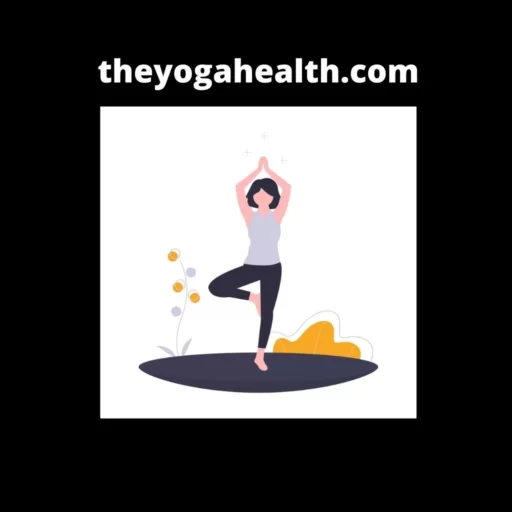Bhramari pranayama is a breathing technique that can quickly calm the mind. It is known as one of the best breathing exercises for relieving mental agitation, frustrations, anxieties, and anger.
Table of Contents
Bhramari Pranayama
The term “Bhramari” comes from the Sanskrit language word “Bhramar,” which means “humming bee”. During this pranayama, a humming sound is created, thus the name Bhramari. The ability of this technique to calm the brain is its greatest advantage.
Regular practice of this pranayama can have positive effects on the mind, helping to reduce stress, fatigue, and high blood pressure. It can also help with problems with the mouth, nose, eyes, and throat.
A scientific study has indicated that practicing this pranayama, along with Udgeeth pranayama, can improve lung function.
This pranayama is known to be effective in treating migraines and paralysis. It is a simple breathing exercise that may be done by people of all ages, including those who are pregnant.
During pregnancy, practicing this pranayama can help regulate the functioning of the endocrine system and contribute to a smooth and easier childbirth.
It is generally recommended to practice this pranayama after completing Anulom Vilom pranayama to maximize its benefits.
How to do Bhramari Pranayama
- Find a comfortable sitting position for your practice. If possible, sit cross-legged on the floor with a cushion or blanket to raise your hips comfortably.
- As an alternative, you may place your feet flat on the ground and saunter to the front of the chair. Make sure your neck, back, and head are all erect and that your spine is stretched.
- Gently close your lips, keeping your teeth slightly apart, and rest the tip of your tongue behind your upper front teeth. Maintain this position throughout the practice and periodically check that your jaw remains relaxed.
- Then, position your index fingers in the middle of your forehead, slightly above your eyebrows, and use your thumbs to cover each ear. Extend your middle, ring, and pinky fingers across your eyes, lightly touching the bridge of your nose.
- Start by inhaling deeply and slowly through your nose, letting the air fill your belly.
- Slowly exhale while lowering your chin to your chest to produce a constant, low-pitched humming sound that sounds like a bee buzzing.
- Focus on making the sound soft, smooth, and consistent. The positioning of your tongue helps the vibration resonate throughout your head, influencing the tissues of your brain.
- Keep your body still and bring your awareness to the center of your head, known as Ajna chakra. Let the sound fill your head and soak your entire being.
- After you’ve finished exhaling, carefully lift your chin and begin the process all over again by taking a deep breath in through your nose. Start with seven repetitions.
- You can continue with seven repetitions or add one more repetition each week, gradually working up to a total of seventeen repetitions.
- After the final exhalation, allow your breath to return to its natural rhythm and observe any changes that have occurred. Keep track of your physical, mental, emotional, and spiritual well-being.
- Notice any energetic shifts resulting from this practice. Pay attention to sensations in your body and how they may have changed since the beginning.
- When you’re ready, gently open your eyes while still maintaining some inner focus. If it’s morning, slowly stand up and bring your full attention to the rest of your day.
- If it’s evening, acknowledge the calm and vibrational state this practice has initiated in your body and try to maintain it as you prepare for sleep.
Please note that the above instructions provide a safe and general introduction to the practice of Bhramari.
Advanced practitioners may incorporate variations such as breath retention (khumbaka), muscular locks (bandhas), or even humming during inhalation (as in ujjayi pranayama).
It is advisable to learn these additional techniques in person from a qualified teacher.
You May Also Like: Anulom Vilom Pranayama
Bhramari Pranayama Benefits
- Bhramari pranayama is an immediate way to alleviate tension, anger, and anxiety.
- It is an effective breathing technique for individuals dealing with hypertension as it helps calm the agitated mind.
- This technique provides relief from mild headaches and the sensation of heat.
- Moreover, it enhances concentration, memory, and boosts confidence.
- By inducing a state of calmness and tranquility, it aids in managing agitation, heart disease, and high blood pressure.
- Regular practice of Bhramari pranayama during pregnancy can contribute to an easier and smoother childbirth.
- Additionally, it is beneficial for individuals suffering from paralysis.
- The humming sound generated during this practice aids in concentration and has a positive impact on both the body and mind, particularly on the nervous system.
- It assists in balancing blood sugar levels and is beneficial for those dealing with Alzheimer.
- For heart patients, this pranayama is highly advantageous as it supports the overall functioning of the cardiovascular system.
- A crucial gland in the body, the pituitary gland, is stimulated by the vibrations caused by the humming sound.
- Furthermore, it can aid in treating insomnia.
You May Also Like: Kapalabhati Pranayama
Precautions:
- Ensure that you avoid inserting your finger or thumb inside the ear canal; simply place them on the outer part of the ear, known as the cartilage.
- Be cautious not to apply excessive pressure on the ear cartilage. Gently press and then release your finger or thumb.
- When producing the humming sound, keep your mouth closed.
- Always practice this pranayama while sitting and refrain from doing it while lying down.
- It is advised not to do this pranayama if you have an ear infection until the infection has subsided.
- Individuals with heart conditions should avoid holding their breath while practicing this pranayama.
- Remember to never force your breathing during the practice.
Conclusion:
Bhramari pranayama offers numerous benefits for both the body and mind. By incorporating this breathing technique into your regular routine, you can experience relief from tension, anger, and anxiety apart from other health benefits.
Remember, before implementing any new breathing method, it is always essential to speak with a healthcare professional if you have any particular health concerns or medical disorders.
FAQs: Bhramari Pranayama
Q1: What is Bhramari Pranayama?
A: This Pranayama is a breathing technique in yoga that involves creating a humming sound while breathing out.
It is derived from the Sanskrit word “Bhramar,” that means humming bee.
Q2: Can Bhramari Pranayama help with hypertension?
A: Yes, this Pranayama can be beneficial for individuals who are suffering from hypertension.
Regular practice of this Pranayama may help in calming the mind and managing high blood pressure.
Q3: Can Bhramari Pranayama help improve concentration and memory?
A: Yes, this Pranayama has been known to enhance concentration and memory.
The humming sound and the focused breathing pattern help to calm the mind and improve cognitive functions of the body.
Q4: Who can practice Bhramari Pranayama?
A: This Pranayama is suitable for people of all ages, including pregnant women.
Before beginning this Pranayama, it is, however, always advised to speak with a certified yoga instructor or a medical expert, especially if you have particular health issues.
Q5: How many repetitions of Bhramari Pranayama should I do?
A: It is recommended to start with seven repetitions of this Pranayama.
Over time, you can gradually increase the number of repetitions based on your available time, comfort level.
But it’s crucial to pay attention to your body’s cues and never push yourself too far.
Q6: How long should I practice Bhramari Pranayama?
A: The time duration of the practice this Pranayama may vary from person to person. Initially, you can start with a few minutes and gradually increase the duration as per your comfort and capability.
Consistency is the key, so regular practice is recommended for optimal benefits.
Q7: Can Bhramari Pranayama be combined with other pranayama practices?
A: Yes, this Pranayama can be combined with other pranayama practices, such as Anulom Vilom Pranayama or Ujjayi Pranayama.
However, it is advisable to learn and practice advanced variations under the guidance of a qualified teacher.
Share your experience of doing this Pranayama and let us know if you have any questions or comments regarding this pranayama in the comments section below.






